House Of Dracula, She-Wolf Of London (1945, 1946)
Directed by: Erle C.Kenton, Jean Yarbrough
Written by: Dwight V. Babcock, George Bricker
Starring: Don Porter, Glenn Strange, Jan Wiley, Jean Hagan, John Carradine, Lon Chaney Jnr, Onslow Stevens, Sara Lockhart
Dr Franz Edelmann, a renowned scientist living in Visaria, has been working on a plant called the clavaria formosa, which has juices that have the ability to reshape bone structure. He aims to cure his hunchback assistant Nina, but is visited by both Dracula and Lawrence Talbot the Wolf Man, both of whom want to be cured of their respective maladies. Thinking Dracula can be cured by blood transfusions, he uses his own blood for the process. He then witnesses Talbot transforming in a prison cell and comes to the conclusion that it’s not the moon but pressures on the brain which is causing his changes. Talbot, unable to wait for Edelmann to begin the process, throws himself off a cliff, but rather then killing himself, he finds the barely-alive Frankenstein Monster in a cave….
House Of Dracula is very similar to House Of Frankenstein in that it never really fulfills the potential of having three monsters [well, four really, and five if you believe the posters that included the pretty hunchbacked Nina as a monster] in one film, but it’s a less episodic piece and is rather more inventive. In fact, the script for this is just plain nuts, which immediately makes it a more interesting film than its predecessor which was itself not short on daftness. As the last of the ‘straight’ Universal monster films [the movie below, She-Wolf Of London kind of exists separately], it shows considerable signs of cheapness and a rushed production, but its sheer verve and pace, like House, just about see it through. It also remains the only other Universal horror picture after Son Of Dracula to scare me as a child and I seem to remember that this was one that, for some reason, I was allowed to stay up and see rather than sneak downstairs after everyone had gone to bed and watch it illicitly.
The origins of House Of Dracula actually go back to Frankenstein Meets The Wolf Man, which was originally intended to have a sequel entitled The Wolf Man Vs Dracula, where a scientist would try unsuccessfully to cure Talbot, Dracula would be after the scientist’s assistant Miliza, and the two monsters would do battle at the end where Dracula would be in giant bat form. Bela Lugosi was intended to return as Dracula. The Hays Office considered Edward T. Lowe’s script, which included many killings by the Wolf Man, to be far too scary and violent, so rejected it outright. After House Of Frankenstein, Lowe was asked to write a follow-up incorporating the same monsters, and used his earlier script as a basis. By now Lugosi was unavailable for a production which was to be made quickly, and corners were certainly cut including the use of footage from The Ghost Of Frankenstein in the climax. This scene, as written, had a flood engulf Edelmann and the Monster, but it was too expensive to film. House Of Dracula was still a moderate success but Universal decided to there was nothing more they could do with their monsters – well, at least for three years….
The previous episode was basically comprised of short sections involving the villainous Dr Niemann, Dracula, The Wolf Man and the Frankenstein Monster. This one, while it again has the Monster comatose until a few minutes at the end, intertwines the other three main characters in a much better way, though it refuses to give any explanation as to how Dracula and Talbot are alive again; they just turn up at Dr Edelmann’s castle. How lazy is that? Still, it’s nice to see Dracula asking to be cured of vampirism. Do we believe him? Does he mean it, or is it just a ploy to get at pretty Miliza? Considering that Dracula could probably get any woman he wanted, I would say that he does mean it, but of course he is Dracula after all and can never withstand his urges for very long. There is a great scene where he enters a room where Miliza is playing Beethoven’s wonderfully atmospheric ‘Moonlight Sonata’ on the piano and she starts playing darker, more atonal music as she falls under his spell. Sadly there’s no big chase this time and Dracula’s end is rather rushed, but never mind, we’re already into the Wolf Man part of the story, and it has some very good aspects indeed as well as some poor ones.
The Wolf Man is only seen briefly in his werewolf form, and never even kills anyone, but there is a rather fascinating scene early on where Talbot is transforming in the prison cell he has asked to be put into and Miliza watches, not with horror, and not even so much with pity, but with an expression that suggests she is actually ‘turned on’ by what she sees. How they snuck this perverse bit of business past the censors I don’t know unless it’s just me and my dirty mind, but watch the scene and you may see what I mean! Sadly the two have few scenes together which is a mistake; sure, we’re all tired of seeing Talbot romancing successive women and it all going wrong, but in this time it all goes right, and Talbot is cured! The scene where he doesn’t change for the first time is rather emotional and very well acted by Chaney, who oddly sports a mustache in this film. The second half of House Of Dracula actually concentrates more on Edelmann, who gets contaminated with Dracula’s blood and transforms into a Mr Hyde-like menace who even goes on a brief rampage. With his whitened face, dark patches under his eyes and his growly voice, he’s a little scary, and he is what frightened me as a child, especially in his first transformation where he sees his shadow disappearing in a mirror!
The cobbled–together climax, which if you think about it largely consists of Chaney fleeing from Chaney, is very lame, though the Monster does feature in a rather good dream sequence earlier where the rapidly degenerating Edelmann is trying to work out what to do, the scene showing some Monster footage from House Of Frankenstein and Bride Of Frankenstein, the two sides of Edelmann and even Nina without her hump! It’s nice to see a film from around this time where someone with a ‘deformity’ is not made out to be ugly, and her character is probably the most rational in the film though she still sadly pays with her life. Lowe’s script bravely tries to add a kind of rationality to the supernatural but shoots itself in the foot with its ridiculous [yes, I know this is a Universal horror movie, but come on!] stuff about mould from a plant which can alter bone structure, and isn’t it convenient that Edelmann stumbles upon a cave full of these plants? I reckon that Onslow Stevens, a very underused actor who gives a really fine performance as both the doctor and his monstrous alter-ego, must have had trouble keeping a straight face at some of the things he has to say, and yet it’s lovely that everyone appears to take it all seriously, with no easy laughs [that would come, though].
House Of Dracula doesn’t look as good as House Of Frankenstein, despite having the same cinematographer and director, though there’s nice use of shadows at times and much symbolic employment of bars. John Carradine again is a really fine Dracula and is even allowed to be sympathetic for a bit. He would go on to play Dracula on stage and in three more films though it’s a great shame that he never starred in an actual cinematic version of Bram Stoker’s novel, considering he’s so close to Stoker’s character. Poor old Glenn Strange is hardly allowed to do anything as the Monster but it’s nice to see Lionel Atwill returning as a policeman; sadly, he was dying of cancer during production. Skelton Knaggs, who was more or less the successor to Dwight Frye in portraying eccentric, sinister background characters, gives a great turn as a constantly grumbling villager. The score is again cobbled together stuff, mostly from Son Of Frankenstein, The Ghost Of Frankenstein, The Wolf Man and Son Of Dracula. It works fine but watching these films in fairly quick succession [roughly one every two weeks] makes me tire of hearing the same music cues over and over again. Overall though House Of Dracula is probably better than it has a right to be, and while tatty and careless in part, sometimes shows real verve and interesting pathways, pathways down which a sequel could have gone down further.
Rating: 









In a London park, people are being found dead with their throats ripped out. Meanwhile Phyllis Allenby is living at the Allenby Mansion, along with her aunt Martha Winthrop, her cousin Carol and the servant Hannah. She is soon to be married to lawyer Barry Lanfield. When another murder occurs at the park, many of the detectives at Scotland Yard begin murmuring about werewolves, while Inspector Pierce believes the opposite and suspects strange activity at the Allenby Mansion [which is near the park], where the “Wolf-Woman” has been seen prowling at night and heading for the park which is nearby. Phyllis, who seems to be the latest of the line in her family to suffer a curse, becomes extremely terrified and anxious that she could be the monstrous killer….
I’m not entirely sure how I feel about She-Wolf Of London [later the title of a 90’s TV series], to be honest. Though the title would indicate that it’s connected to Werewolf Of London, in fact it has nothing to do with it and, more than that, not really much to do with the Universal horror cycle at all. It’s more of a suspense mystery, coming across at times as a Basil Rathbone Sherlock Holmes adventure without Sherlock Holmes [Dennis Hooey, who played Inspector Lestrade in some of the Rathbone films, even turns up again as a cop], but it also bears great similarities to quite a few other films, so much so that it fails to have much of an identity of its own. It’s reasonably enjoyable and has a few well done scenes where signs of a far better film appear, but just doesn’t have an original bone in its body and shows evidence of being both cobbled together or chopped up, with gaping holes and unexplained matters all over the place. It isn’t even as suspenseful as it ought to be, though overall you cannot really it’s a bad movie, just an rather poor one.
She-Wolf Of London appears to have had a troubled production, though little information seems to exist about it. The director Jean Yarbrough had nothing of distinction to his name and had developed a reputation of making films quickly and under budget, but also of editing ‘in camera’ and not doing retakes, something that causeded his films to be full of mistakes. She-Wolf Of London appears to have been intended to be a rather darker movie than the one that eventually came out, though how precisely is unclear. What is known is that is that it was extensively cut and re-edited, perhaps because many parts of the film looked sloppy and didn’t even come up to the standards of films like House Of Dracula, though this was done with some damage to the plot. Certainly footage of two of the characters as children was removed, with the performers still credited on screen. Oddly enough, some new scenes were shot as well, perhaps to try and mask the edits, making some of the cast work through Christmas Eve even though shooting supposedly ended four days before. None of this really helped the film which was a commercial disappointment, with many people feeling cheated by a supposed ‘werewolf’ picture that didn’t actually have a werewolf, even despite it often being billed with The Cat Creeps, another non-supernatural mystery with a few horror elements. In the UK it was retitled The Curse Of The Allenbys.
The first thing that hits you about She-Wolf Of London is how unconvincing and anachronistic it seems. It’s supposedly set in London, but the sets, one of which was a slightly redressed set used in many Westerns, look patently American and none of the props look right. When people actually do attempt an English accent they sometimes sound like something even Dick Van Dyke would be ashamed of, and shoddy continuity ensures that you can see things like people wearing wet clothes in the same outdoor shots as people that are wearing dry clothes. Many films have this kind of thing but the fact that it’s all so noticeable in this one means that the picture just isn’t good enough overall. Being as I live near London and visit it often, I would personally like to have known which park the killings are supposed to be taking place, as not only is it not named but looks like no park I know. The fog-shrouded locale, the kind of place you’d expect The Hound Of The Baskervilles to jump out of but with more trees, is quite atmospheric though and scenes where the She-Wolf stalks her prey from behind, making no sound, are quite chilling and probably the film’s highlights.
Yes, it’s made quite clear that this is a more human menace, with numerous shots of a hooded female figure, though she does make some growling noises which are rather effective. The film proceeds as a reasonable mystery, though on first viewing I guessed immediately who the She-Wolf was. Her face is shown half with one side in shadow and one side in light; a nice device, but a total giveaway. Considering that though I love mysteries I’m not very good at guessing killers, I would say that is not a good thing! If you don’t guess who it is early on, than you may certainly think that the supposed ‘heroine’ really is the killer and June Lockhart gives a rather good, anguished performance as someone to whom all the evidence points to as a monstrous killer and who even believes it herself. Unfortunately, little happens apart from a couple of park stalkings, and the majority of the film, set in the Allenby house, is not quite atmospheric enough to allow for this, despite the almost constant sound at night of baying dogs. The climax of this none-too-exciting production is over in no time; you have the ‘big’ revelation, and then the killer falls unconvincingly down the stairs onto a knife. Surely it would have been far better to finish off in the park?
The script seems to borrow bits and pieces from not only Devil Bat’s Daughter [a woman is led to believe she is a vampire], but possibly The Undying Monster and Cat People too and more ‘conventional’ thrillers like Gaslight. The murder weapon is the same as that in possibly the very best of the Rathbone Holmes’s, The Scarlet Claw. Whirling POV shots indicating drugging are just like ones in Hitchcock’s Notorious, while I’ll be very surprised if the two scenes of someone going upstairs with a glass of milk were not influenced by another Hitchcock movie, Suspicion. None of this is as bad though as the huge story holes, such as the killer saying that her first murder was of a young boy, yet we are told at the beginning there have been killings in the park before the boy was killed. We aren’t told what the ‘curse of the Allenbys’ [read curse of the Baskervilles] actually is, nor even given an explanation for the growling noises when the She-Wolf attacks, noises which are then totally absent in the climax.
Yarbrough directs efficiently; knowing his reputation and shooting style, you’d expect the direction to seem a lot worse, though it is almost entirely without personality. Aside from June Lockhart, Sara Hagen is strong as Phyllis’s aunt Martha, though it’s really the sort of dour, grumpy spinsterish role she usually played. William Lava’s score is rather effective in its downbeat way, quite skilfully backing the action [or lack of it], if forgettable. He later on became a scorer of Loony Tunes shorts. The weird thing about She-Wolf Of London is that one can spend the best part of a review criticising it, which I am certainly doing, yet it somehow retains some interest. It’s frustrating to watch but you’ll probably keep on watching it. Perhaps it’s the hints [which are not explored] of a kind of lycanthropy which is more psychological than physical, or maybe it’s just because of its sheer gall in stealing from everything? I wonder if it would come across as better if it had never been considered part of Universal’s horror series at all?
Rating: 










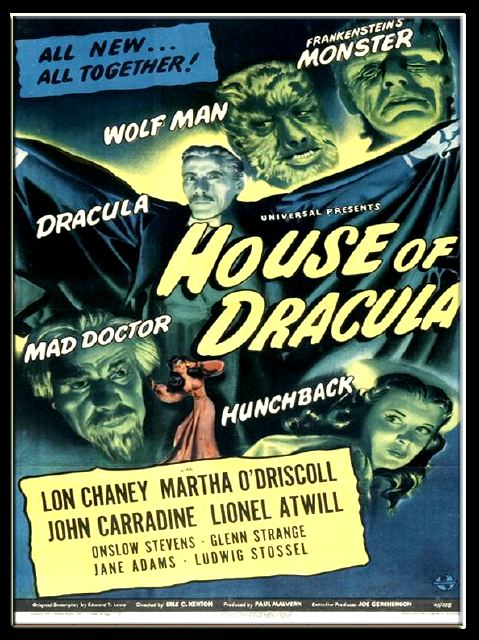
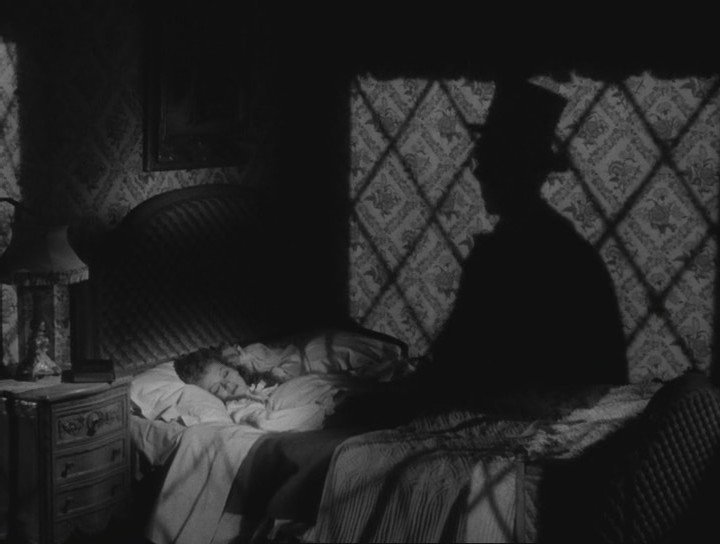
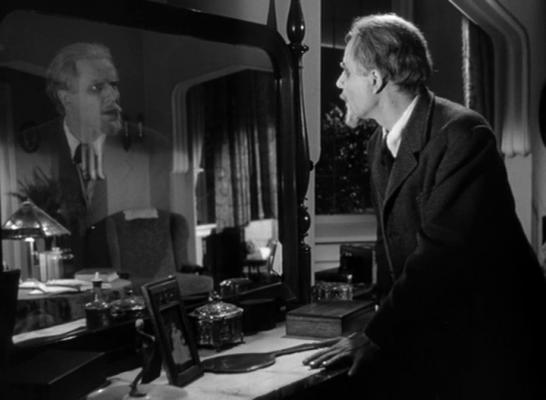
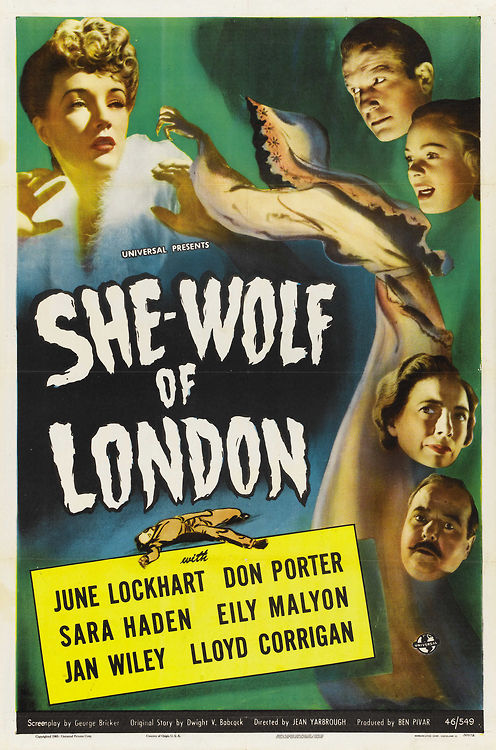
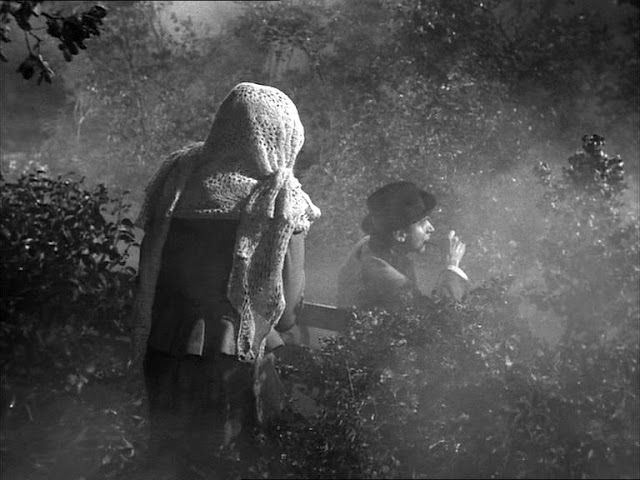
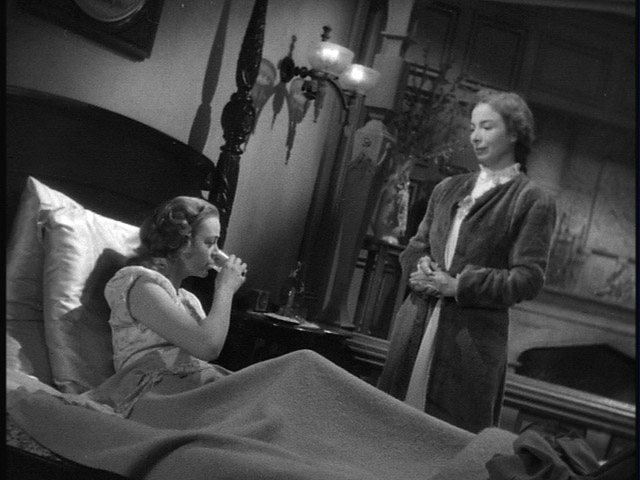

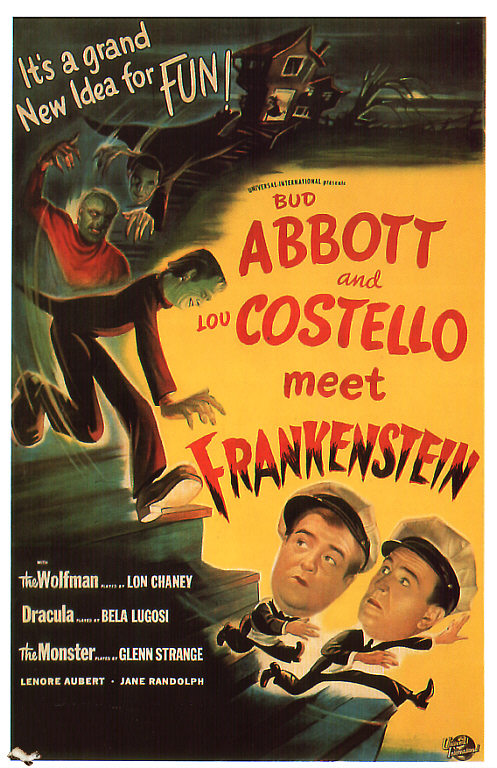
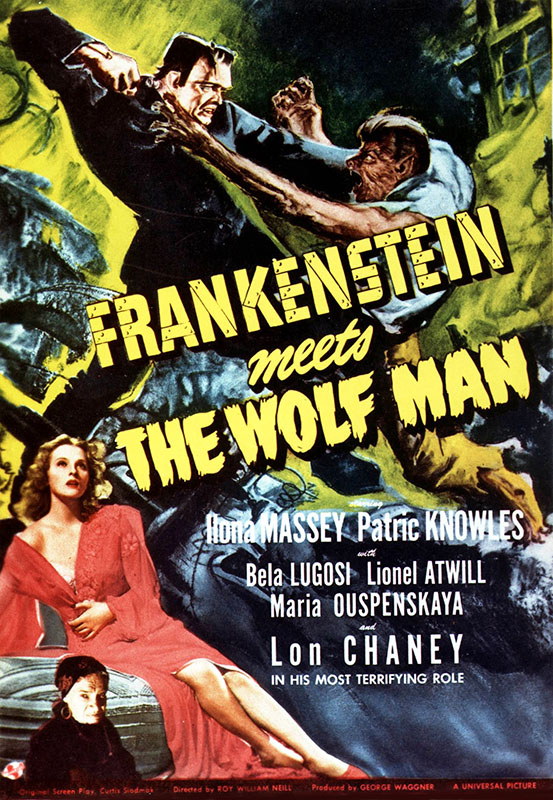
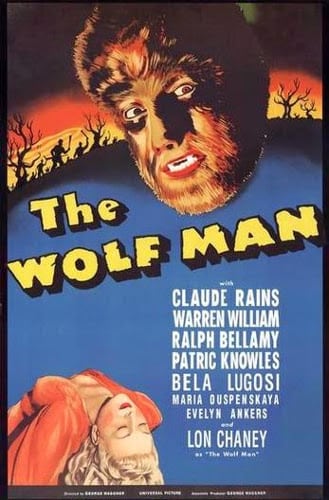
Be the first to comment